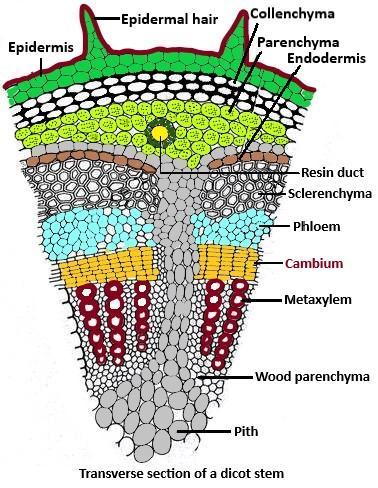Answer
379.8k+ views
Hint: Plants can be classified as non-flowering and flowering plants which are further divided into two categories that include monocotyledons and dicotyledons. Cotyledons are present in seed-bearing plants and are called the embryonic leaf.
Complete answer: The dicot stem is a part of the dicotyledons. Dicotyledons are flowering plants that consist of two embryonic leaves also known as cotyledons as mentioned earlier. Dicot stems consist of an epidermis which comprises cuticle and multicellular stem hair. A dicot stems internal structure consists of epidermis, cortex endodermis (Collenchyma, parenchyma, and endodermis), pericycle (sclerenchyma), vascular bundles (xylem, phloem, cambium, and wood parenchyma), and a pith. Examples of flowering plants that have a dicot stem include Cucurbita and sunflower.
The cambium is a layer of cells that divides phloem and xylem tissues. The cambium cells are responsible for the stem girth expansion, the secondary growth of roots, and the stem. The cambium which is located within the vascular bundles, that is between the primary phloem and primary xylem is called the intrafascicular cambium. Whereas, during the occurrence of secondary growth, interfascicular cambium is formed due to the medullary ray cells becoming meristematic in nature. Both the intrafascicular cambium and interfascicular cambia join to form a cambium ring that separates the primary xylem and phloem.

Therefore, the correct answer is option B, i.e., Intrafascicular.
Note: The shoot system, simply known as the stem provides structural support and carries out functions such as producing new living tissues, transporting nutrients and water from the roots to different parts of the plant such as leaves, flowers, and fruits via xylem and phloem. The Kingdom Plantae consists of about 320,000 different species of plants out of these approximately 100,000 to 150,000 are dicot plant species.
Complete answer: The dicot stem is a part of the dicotyledons. Dicotyledons are flowering plants that consist of two embryonic leaves also known as cotyledons as mentioned earlier. Dicot stems consist of an epidermis which comprises cuticle and multicellular stem hair. A dicot stems internal structure consists of epidermis, cortex endodermis (Collenchyma, parenchyma, and endodermis), pericycle (sclerenchyma), vascular bundles (xylem, phloem, cambium, and wood parenchyma), and a pith. Examples of flowering plants that have a dicot stem include Cucurbita and sunflower.
The cambium is a layer of cells that divides phloem and xylem tissues. The cambium cells are responsible for the stem girth expansion, the secondary growth of roots, and the stem. The cambium which is located within the vascular bundles, that is between the primary phloem and primary xylem is called the intrafascicular cambium. Whereas, during the occurrence of secondary growth, interfascicular cambium is formed due to the medullary ray cells becoming meristematic in nature. Both the intrafascicular cambium and interfascicular cambia join to form a cambium ring that separates the primary xylem and phloem.

Therefore, the correct answer is option B, i.e., Intrafascicular.
Note: The shoot system, simply known as the stem provides structural support and carries out functions such as producing new living tissues, transporting nutrients and water from the roots to different parts of the plant such as leaves, flowers, and fruits via xylem and phloem. The Kingdom Plantae consists of about 320,000 different species of plants out of these approximately 100,000 to 150,000 are dicot plant species.
Recently Updated Pages
How do you arrange NH4 + BF3 H2O C2H2 in increasing class 11 chemistry CBSE

Is H mCT and q mCT the same thing If so which is more class 11 chemistry CBSE

What are the possible quantum number for the last outermost class 11 chemistry CBSE

Is C2 paramagnetic or diamagnetic class 11 chemistry CBSE

What happens when entropy reaches maximum class 11 chemistry JEE_Main

Calculate the volume occupied by 88 gram of CO2 at class 11 chemistry CBSE

Trending doubts
Difference Between Plant Cell and Animal Cell

Difference between Prokaryotic cell and Eukaryotic class 11 biology CBSE

Fill the blanks with the suitable prepositions 1 The class 9 english CBSE

Change the following sentences into negative and interrogative class 10 english CBSE

How many millions make a billion class 6 maths CBSE

Fill the blanks with proper collective nouns 1 A of class 10 english CBSE

Give 10 examples for herbs , shrubs , climbers , creepers

What organs are located on the left side of your body class 11 biology CBSE

What is BLO What is the full form of BLO class 8 social science CBSE



